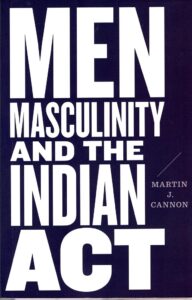Book review: Men, Masculinity and the Indian Act
Men, Masculinity and the Indian Act is a well-written complex argument about sexism and racialization under Canada’s Indian Act. To follow Cannon’s arguments, one needs to recognize that the Indian Act racialized Indigenous nations and peoples through the legislated category of Indian. Within this racialized category, the Indian Act imposed a form of nineteenth-century European male patriarchy on Indigenous communities. For Cannon, racialization and gender discrimination are therefore inseparable and need to be addressed as a joint force impacting First Nations. To effectively rid ourselves of internalized colonialisms, we must address and eliminate this duo-archy. It is under this concept that he addresses how men are affected by the sexism within the Indian Act, and how we as ‘Indian’ males must acknowledge and reject sexism.
Chapter One, “The Indian Act, a Legacy of Racist Patriarchy”, explores the history of the racist-sexist legislation, its colonial rationales, and uses. Importantly, Cannon notes that the legislation was largely designed to eliminate Indians.
Chapter Two, “Sexism, Racialized Injustice, and Lavell v. Canada,” discusses the 1974 Bedard-Lavell case in which the Supreme Court of Canada failed to consider the issue of race and the idea of substantive inequality (treating people the same may produce discrimination) within the context of the 1960s and 1970s. He notes that Justice Laskin, who wrote the dissenting opinion, noted that the Court was acting as if Indian women have a choice in being either an Indian or a woman. Nonetheless, the majority decision in 1974 effectively reinforced settler sovereignty.
In Chapter Three, Cannon explores the “Individual versus Collective Rights in Status Indian Politics, 1985 -99” as a case of how patriarchy was being used partly to subvert European ideas and encroachments while at the same time being internalized by First Nations. This discussion ably illustrates the complexity and results of the duo-archy of racialization and sexism on Indigenous politics and peoples. It also shows how the state continued to benefit by the artificial separation of race and sex, thereby allowing it to continue its colonialist settler policies of eliminating Indians and confirming its control over First Nations.
The final chapter, “Sexism, Indigenous Sovereignty, and McIvor v. The Registrar, 2007-09”, shows how the Canadian states and its courts remain unable to see a linkage between racialization and sexism. Recently, Cannon notes, legislation is limited to addressing the effects of the Indian Act sections dealing with status as determined by court decisions. Cannon argues that the state continues through its legislation to limit changes to statutory definitions and refuses to address the history of colonialism and racialization holds. For in the end, by retaining control of ‘Status’, the state is seeking to continue to eliminate Indians thereby claiming the lands by statutory fait rather than working through a nation-to-nation framework.
The conclusion offers a summation of the main points, as well as some solutions. Simply, Cannon proposes that Indigenous men need to recognize and reject the colonially created forms of gender discrimination by embracing our traditions and teachings. Without Indigenous men returning and acting as our Nation’s traditions to inform our cultures, we as Indigenous Nations cannot escape from the colonial cycle.
He also argues that we as Indigenous people must continue to press Canada on its colonialism and racialization of Indigenous peoples. Finally, he notes that women’s efforts to undo the Indian Act are part of a resurgence and recognition of Indigenous Nationhood, and not merely a singular demand to gender equity.
Cannon’s work expands on other materials that discusses settler colonialism and the Indian Act.
Cannon ably argues that Canada and its courts by separating Indian and woman have managed to avoid a reckoning and deftly avoided questions of Indigenous sovereignties and Nationhood by offering people a choice that makes no sense – one cannot be an Indian or a woman.
Overall, the book is a must-read to understand how the Indian Act, the settler states, and its courts have created and reinforced the duo-archy of racialization and sexism for Canada’s benefit.
Martin J. Cannon, Men, Masculinity and the Indian Act. Vancouver: University of British Columbia Press, 2019.



